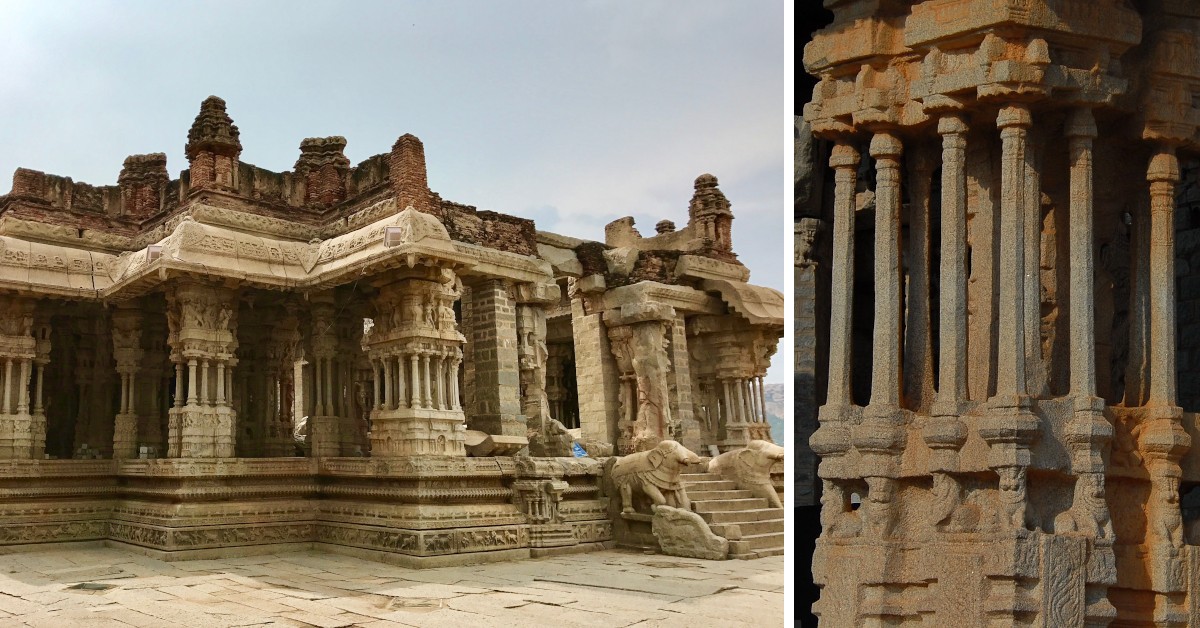The ‘SaReGaMa Pillars’, as the famous musical pillars of Vittala Temple in Hampi, India, are also called, play individual notes when tapped.

The Vittala Temple in Hampi is a genuine masterpiece in terms of grandeur and architecture. Words will fall short to express the beauty of this sprawling compound that houses pavilions, halls and many other temples. But the place is more known for 56 mysterious pillars, each 3.6 meters high, which produce delicate musical notes when struck. Tourists have long been travelling to the UNESCO World Heritage Site to hear the over 500-year-old temple’s mesmerizing music.
The pillars are named SaReGaMa after the first four notes (svaras) of the standard scale in Indian classical music, which is similar to the Western Do Re Mi Fa (solfège). Together, they hold up the 15th-century ‘Ranga Mantapa’, the main attraction within the temple complex which resembles an open pavilion and was most likely used for music and dancing. There is a set of main pillars and many smaller ones, with the main ones designed in the style of musical instruments. Each main pillar is wrapped with seven minor pillars that each ‘play’ one of the seven notes in the Indian classical music scale.
But how do these pillars create different sounds if they were apparently created of the same material? Are there holes inside the granite, explaining the various sounds that the pillars produce? Well, the British tried to figure it all out by cutting one of the larger pillars and also one of the smaller ones. But there was no revelation, as the pillars proved to be the same – solid rock!
If the height, weight or diameter of the pillars were different, their making different sounds would be justifiable. But no, all the columns are the same in dimension, yet they produce different musical notes.

The first scientific investigation of the musical pillars’ acoustic properties was conducted in 2006–07 by scientists from the Indira Gandhi Centre for Atomic Research in Kalpakkam, Tamil Nadu. The research team examined the eleven most popular pillars using non- destructive techniques such as low-frequency ultrasonic testing and in-situ metallography. The latter technique revealed that the microstructure of the pillars was similar to a typical granite microstructure, while the low-frequency ultrasonic and impact echo testing showed that all the musical columns are solid shafts.
Most of the sounds from the pillars were found to correlate with different ancient Indian percussion instruments like the Kerala mridangam, tabla, ghatam and damaru. The other musical sounds identified were that of the veena, jaltarang, shankha, ghanta, panchtala and saptaswara. Still, no explanation was found to the question of why the pillars sound differently when they are the same in dimension.
This video by YouTuber Praveen Mohan suggests some interesting options, from the use of rock melting technology to cymatics.
Vijaya Vittala is not the only temple in India to feature musical pillars. Similar pillars in Nellaiappar Temple in Tirunelveli are arranged so that when one pillar is tapped, a neighboring one reverberates, producing a bell-like sound.
Other temples feature other musical architecture, such as staircases. At the Airavateshwara temple in Darasuram, for example, a set of stairs leading into the temple ‘play’ the first seven notes of the Indian classical music scale when someone steps on them.
For a period of about 200 years between the 14th and 16th centuries, these harmonious hallmarks represented an exciting revolution in architecture, particularly in the south of India.

Today, the pillars at Vijaya Vittala are cordoned off to prevent further damage to the stone instruments caused by curious visitors tapping them to hear their music (the pillars were originally sounded using sandalwood, as suggested by the intricate carvings in the temple). Many other temples have made a similar move to protect their astounding musical structures.
Sources: 1, 2, 3
